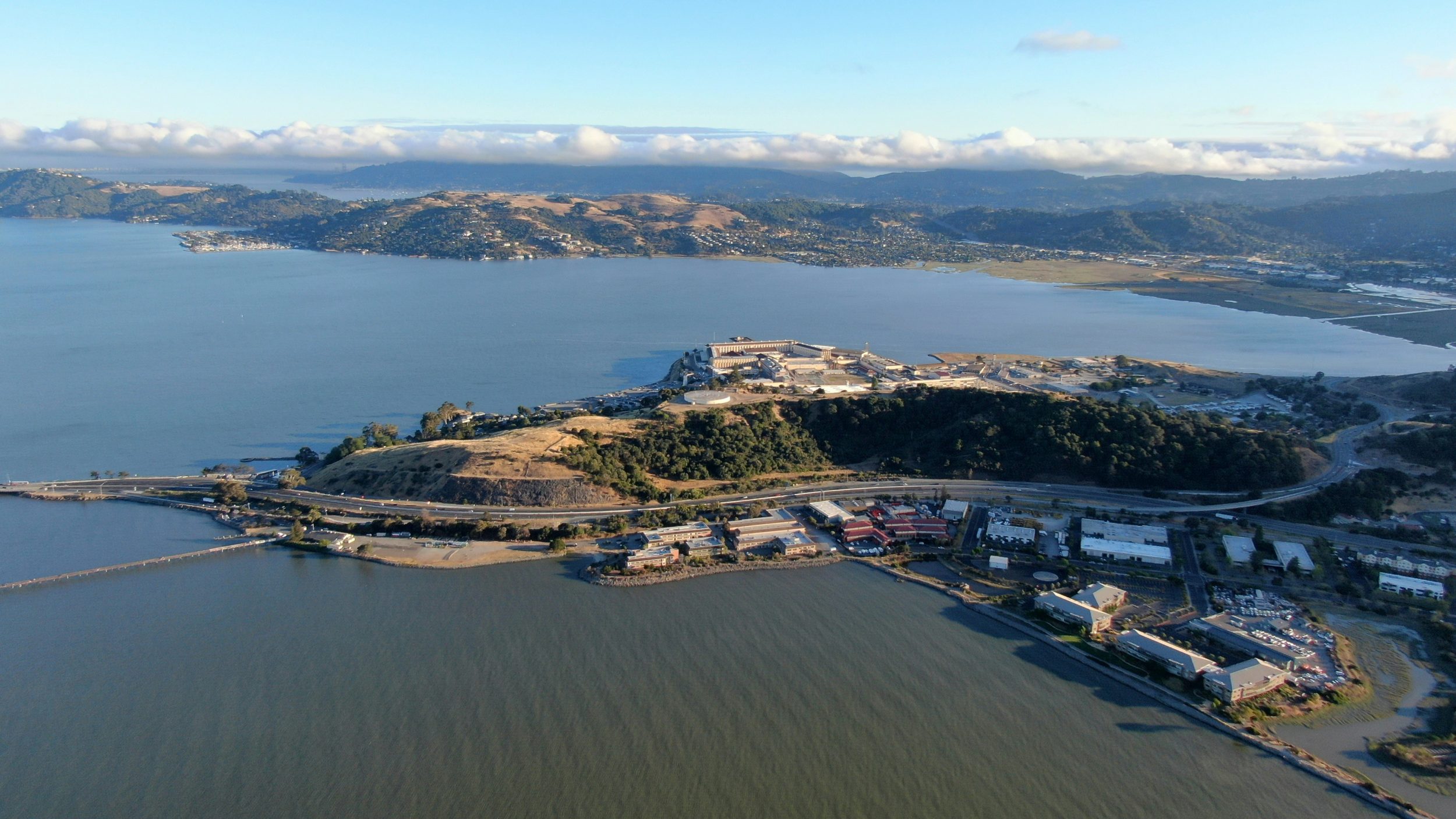In October, the inaugural San Quentin Film Festival welcomed a select list of media influencers to enter the prison to attend two days of workshops as well as screenings of work by currently and formerly incarcerated filmmakers. While the festival garnered praise from its celebrity attendees and received extensive media coverage, it’s crucial to question the “model prison” narrative it presented.
San Quentin Rehabilitation Center, just across the Golden Gate Bridge from San Francisco, is California’s most visible prison. With its sand-colored walls stretching out into the San Francisco Bay, the image of San Quentin is deceptively pristine. The prison’s proximity to progressive activism in Berkeley, Oakland, and San Francisco has enabled it to host college classes, art workshops, and podcasts such as Ear Hustle, which gained mainstream success and even a Pulitzer Prize nomination. (One of Ear Hustle’s former “inside” hosts, Rahsaan “New York” Thomas, is the man behind the festival.)
But this polished front offers a selectively curated image of prison life—one far removed from the reality faced by most incarcerated individuals in the state. For the majority, access to meaningful programs, educational resources, and basic opportunities for rehabilitation remains scarce. This disparity reveals San Quentin less as a model for other prisons and more as an exception, even a facade, maintained by the prison system to mask systemic neglect and justify inhumane practices across California.
All forms of imprisonment in the United States serve to dehumanize, isolate, and outcast, so I wouldn’t go as far as to say that San Quentin is a “good” prison. Still, projects such as the film festival and Ear Hustle are examples of rehabilitative programs that are both effective and possible within the confines of our current system of incarceration. The controversial commitment of $360 million to San Quentin as part of Governor Gavin Newsom’s transformation plan has already helped add additional facilities to aid in emotional, mental, and interpersonal development, such as a recording studio, and more are slated, including a better art studio and an enhanced medley of trade skill courses.
The funding of San Quentin is considerably higher than what is allocated for most other prisons in the state, particularly those in rural areas. Those prisons’ much smaller budgets are focused primarily on maintaining basic operations rather than enhancing rehabilitation programs. Most of the incarcerated men and women I’ve worked with, caged in remote areas of the state such as Kern Valley and Vacaville, are denied access to even basic tools, never mind programs that train individuals for jobs on the outside—programs such as The Last Mile, which has taught IT courses at San Quentin. Ivan Kilgore, an incarcerated activist serving a life sentence, wrote Domestic Genocide: The Institutionalization of Society, a 350-page critique of racial capitalism, from a California maximum-security prison. He was required to write it in one-hour increments—his daily allotment—on the prison’s only computer, located in the middle of a gymnasium. Numerous members of the media—Jon Stewart, CNN’s Lisa Ling, PBS’s Frontline team, and NBC News’ Lester Holt, to name a few—have been escorted through the halls of San Quentin. Meanwhile administrators at Kilgore’s current facility, CSP Solano, would not even permit me to document my first meeting with Kilgore since the release of my book, in which he and his organization, the United Black Family Scholarship Foundation, feature prominently. Unlike San Quentin, Solano is not a prison they want you to see.
Media and public perception are shaped by selective transparency, whether that be your algorithmically prescribed social media feed or the discrepancies between a political candidate’s rhetoric and actual policy plan. As Noam Chomsky observed, “The smart way to keep people passive and obedient is to strictly limit the spectrum of acceptable opinion, but allow very lively debate within that spectrum.”
Some of the debate around prison programs stems from taxpayers critical of seeing their money spent on educating and supplying services and materials to incarcerated people. This narrative is inherently flawed.
Californians pay exorbitant amounts for an ineffective system that then wastes enormous quantities of that money. For example, taxpayers are currently footing the bill for more than 15,000 empty prison beds, wasting hundreds of millions of taxpayer dollars. This is money spent on maintaining capacity, not on reducing recidivism or helping incarcerated individuals successfully reintegrate into society. Consider the approximately $182 million spent between 2020 and 2021 to operate Deuel Vocational Institution during its “warm shutdown,” when no one was incarcerated there. That money could have been better used to fund programs proven to reduce crime and keep people out of the prison system in the first place.
Decarceral thinkers and doers
Every week, Inquest aims to bring you insights from people thinking through and working for a world without mass incarceration.
Sign up for our newsletter for the latest.
Newsletter
Currently only around 4 percent of California’s incarcerated population is housed in San Quentin and thus able to benefit from the programming there. Roughly 40,000 Californians are released from the state’s prisons each year, and the overwhelming majority of them have been in prisons more like Solano than San Quentin. The system has not prepared them with a path toward success and away from recidivism.
Prison programming—whether educational, vocational, or therapeutic—has been shown to lower recidivism rates, which translates into fewer individuals cycling in and out of the system. Studies consistently show that rehabilitative programs reduce reoffending, ultimately saving taxpayer money by decreasing future incarceration costs. By investing in rehabilitation instead of empty prison beds, California can reduce the overall prison population and make a more efficient use of its resources, leading to long-term savings and safer communities.
So, the real question isn’t whether taxpayers should pay for programming—it’s whether we want to continue wasting billions maintaining a broken system, or invest in solutions that can reduce incarceration altogether.
The San Quentin Film Festival is a reminder that while one prison gets the feel-good glare of the spotlight, most remain in the shadows. The event should be celebrated, publicized, and continued, but it should also serve as a reminder to advocate for education, arts, and rehabilitative programs for all incarcerated individuals—not just those whose rehabilitation journeys we are permitted to see.
Image: Nathan Barteau/Unsplash

